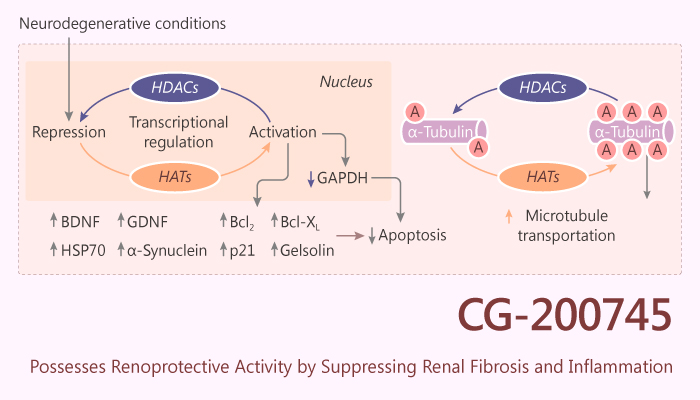In cancer, CG-200745 is a novel and potent hydroxamate-based pan-HDAC inhibitor. Moreover, another study from Hong Sang Choi demonstrated that CG200745 attenuates renal fibrosis in obstructive kidney disease.

Epigenetic modifications such as DNA methylation or histone acetylation are regarded as essential steps in the development of acute kidney injury (AKI), CKD, and the progression of AKI to CKD. Therefore, they have been studied to identify epigenetic changes that occur in kidney injury and therapeutic targets. Histone modifications, which are epigenetic markers that regulate chromatin structure and gene expression, have been studied extensively in relation to kidney damage. Additionally, in normal cells, histone acetylation is precisely controlled by histone acetyl-transferase (HAT) and HDAC. HDACs remove acetyl groups from histones. HDAC inhibitors mainly act on a zinc domain and cause cell cycle arrest, differentiation, and apoptosis.
Subsequently, several HDACs express in the developing kidney, renal tubules, and fibroblasts. CG200745 represents a pan-HDAC inhibitor. CG200745 not only increases H3 acetylation but also acetylation of non-histone proteins such as tubulin and p53. This novel HDAC inhibitor has an effective anticancer activity against colon cancer, prostate cancer, non-small cell lung cancer, pancreatic cancer, and cholangiocarcinoma cell lines. Here, we investigated the renoprotective effects of CG200745 in a mouse model of obstructive uropathy.
In addition, in vivo, CG-200745 (p.o.; 30 mg/kg/day; for 7 days) attenuates oxidative stress, inflammatory cytokines, and adhesion molecules in UUO kidneys.
To conclude, CG-200745 possesses renoprotective activity by suppressing renal fibrosis and inflammation